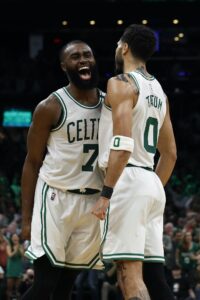Hoops Rumors is in the process of taking a closer look at each NBA team’s current roster situation, evaluating which clubs still have some moves to make and which ones seem most prepared for training camp to begin.
This series is meant to provide a snapshot of each team’s roster at this time, so these articles won’t be updated in the coming weeks as more signings, trades, and cuts are made. You can follow our roster counts page to keep tabs on teams’ open spots as opening night nears.
We’re continuing our pre-camp Roster Snapshot series today with the Atlantic Division. Let’s dive in…
Boston Celtics
- Players on guaranteed standard contracts: 10
- Players on non-guaranteed standard contracts: 2
- Al Horford (partial guarantee), Luke Kornet (partial guarantee)
- Players on Exhibit 10 contracts: 1
- Players on two-way contracts: 2
- Restricted free agents: 1
- Brodric Thomas (two-way)
- Players who have reportedly reached contract agreements: 2
Horford is a lock to be on the Celtics’ 15-man regular season roster and Kornet’s partial guarantee gives him an inside path. If we assume Boston will start the season with a roster spot open in order to maintain roster flexibility and reduce the team’s tax bill, that leaves two spots up for grabs.
Caboclo, Valentine, Vonleh, and Thomas will all likely be in the mix for those openings, and the C’s have the spots necessary on their 20-man offseason roster to bring in a couple more camp invitees to take part in that competition.
Brooklyn Nets
- Players on guaranteed standard contracts: 12
- Players on non-guaranteed standard contracts: 2
- Edmond Sumner (partial guarantee), Yuta Watanabe
- Players on two-way contracts: 1
- Restricted free agents: 1
- David Duke (two-way)
- Players who have reportedly reached contract agreements: 2
- Markieff Morris, Donovan Williams (Exhibit 10)
After hanging onto Durant and Irving, the Nets are still working on filling out their roster. It’s possible some combination of Sumner, Watanabe, and Morris will fill the remaining two or three spots on the 15-man squad, but it wouldn’t be shocking if Duke works himself into that mix or if Brooklyn brings in another veteran free agent or two to compete for a roster spot.
If Duke doesn’t get a promotion to the Nets’ 15-man roster, he’s the best bet to fill the open two-way slot next to Williams.
New York Knicks
- Players on guaranteed standard contracts: 13
- Players on two-way contracts: 2
- Players who have reportedly reached contract agreements: 2
- Garrison Brooks (Exhibit 10), Jean Montero (Exhibit 10)
Up until Thursday, it looked like the Knicks’ roster may still undergo a major overhaul, with the possibility of a Donovan Mitchell trade threatening to shake things up. Now that Mitchell is headed to Cleveland, New York’s offseason to-do list appears nearly done.
The Knicks do still have two openings on their 15-man roster and aren’t in any danger of going into tax territory, so they could comfortably fill both of those remaining spots. A veteran free agent signing or two is one possibility — New York could also look to make a minor trade, or could wait until the preseason to see which players currently on rosters might shake loose as teams make cuts.
Philadelphia 76ers
- Players on guaranteed standard contracts: 12
- Players on non-guaranteed standard contracts: 4
- Charles Bassey (partial guarantee), Isaiah Joe, Trevelin Queen (partial guarantee), Paul Reed
- Players on Exhibit 10 contracts: 1
- Players on two-way contracts: 2
- Players who have reportedly reached contract agreements: 1
- Aminu Mohammed (Exhibit 10)
With 12 players on guaranteed contracts and four on partially guaranteed or non-guaranteed deals, the Sixers will have to trade or release at least one player before opening night.
Given how close they are to the hard cap, the 76ers seem more likely to cut a player who doesn’t have a full guarantee in order to create a little extra flexibility, so Queen and Joe are among those who could be in danger. A trade involving a player like Korkmaz also shouldn’t be ruled out, though it will be trickier to pull off.
Toronto Raptors
- Players on guaranteed standard contracts: 13
- Players on non-guaranteed standard contracts: 4
- Dalano Banton (partial guarantee), Justin Champagnie (partial guarantee), Josh Jackson (exact details TBD), D.J. Wilson (partial guarantee)
- Players on Exhibit 10 contracts: 1
- Players on two-way contracts: 2
- Restricted free agents: 2
- Jalen Harris (two-way), David Johnson (two-way)
Even after waiving Svi Mykhailiuk, the Raptors have a crowded roster. It seems likely that all 13 players on guaranteed contracts will open the season on the 15-man squad — Hernangomez may not be a lock, but Toronto wouldn’t have given him a fully guaranteed salary if he wasn’t part of the team’s plans.
If we pencil in those 13, it leaves two open spots for Banton, Champagnie, Jackson, Wilson, and possibly two-way RFAs Harris and Johnson. The latter two are wild cards, since they could also factor into the two-way picture if Toronto is willing to carry one or both of them over Dowtin and/or Harper. There’s plenty still to be sorted out here.
Previously:
 Brown has never made an All-NBA team, but he was an All-Star in 2021 and received All-NBA votes in 2022, so he could very well be in the mix in 2023.
Brown has never made an All-NBA team, but he was an All-Star in 2021 and received All-NBA votes in 2022, so he could very well be in the mix in 2023.